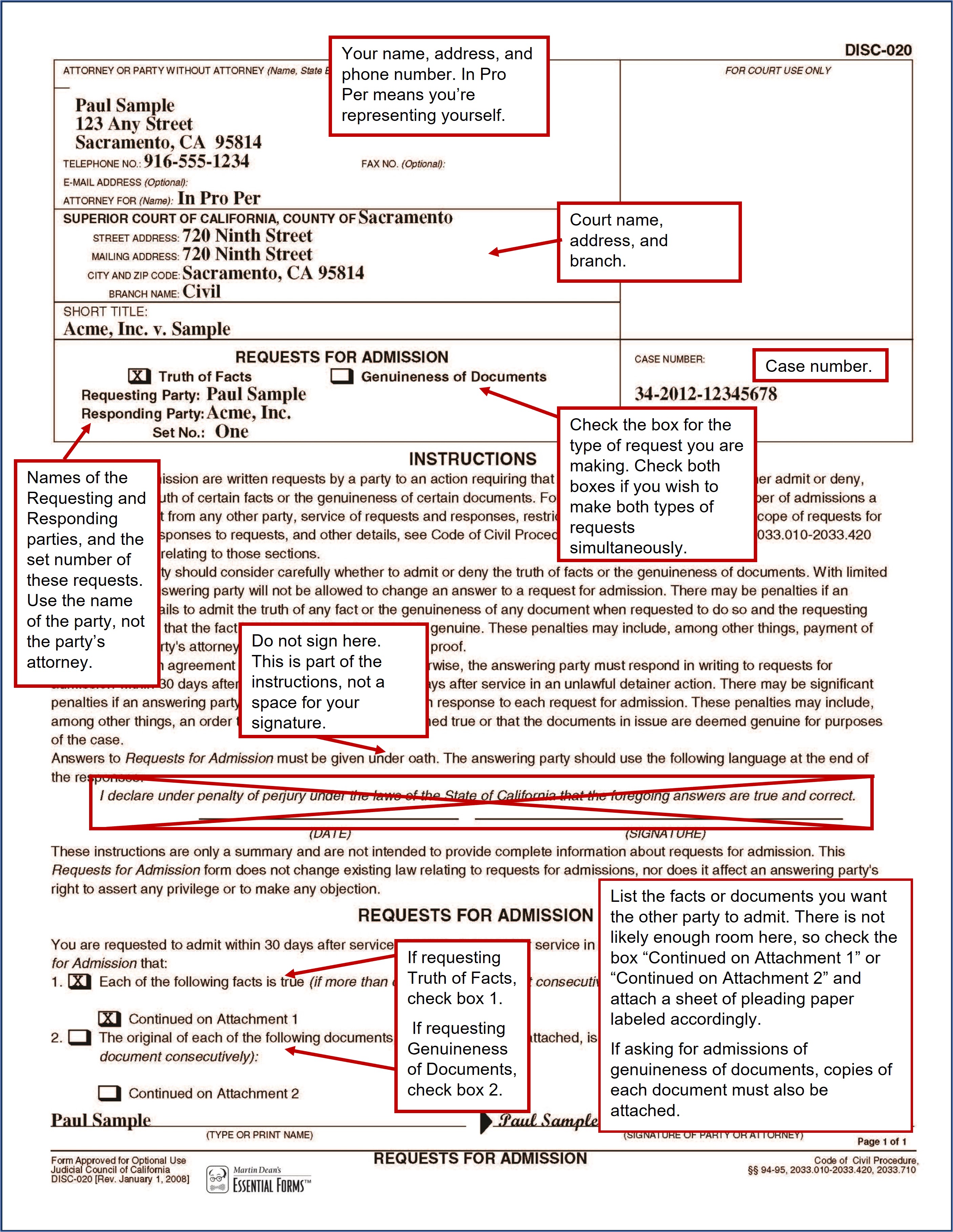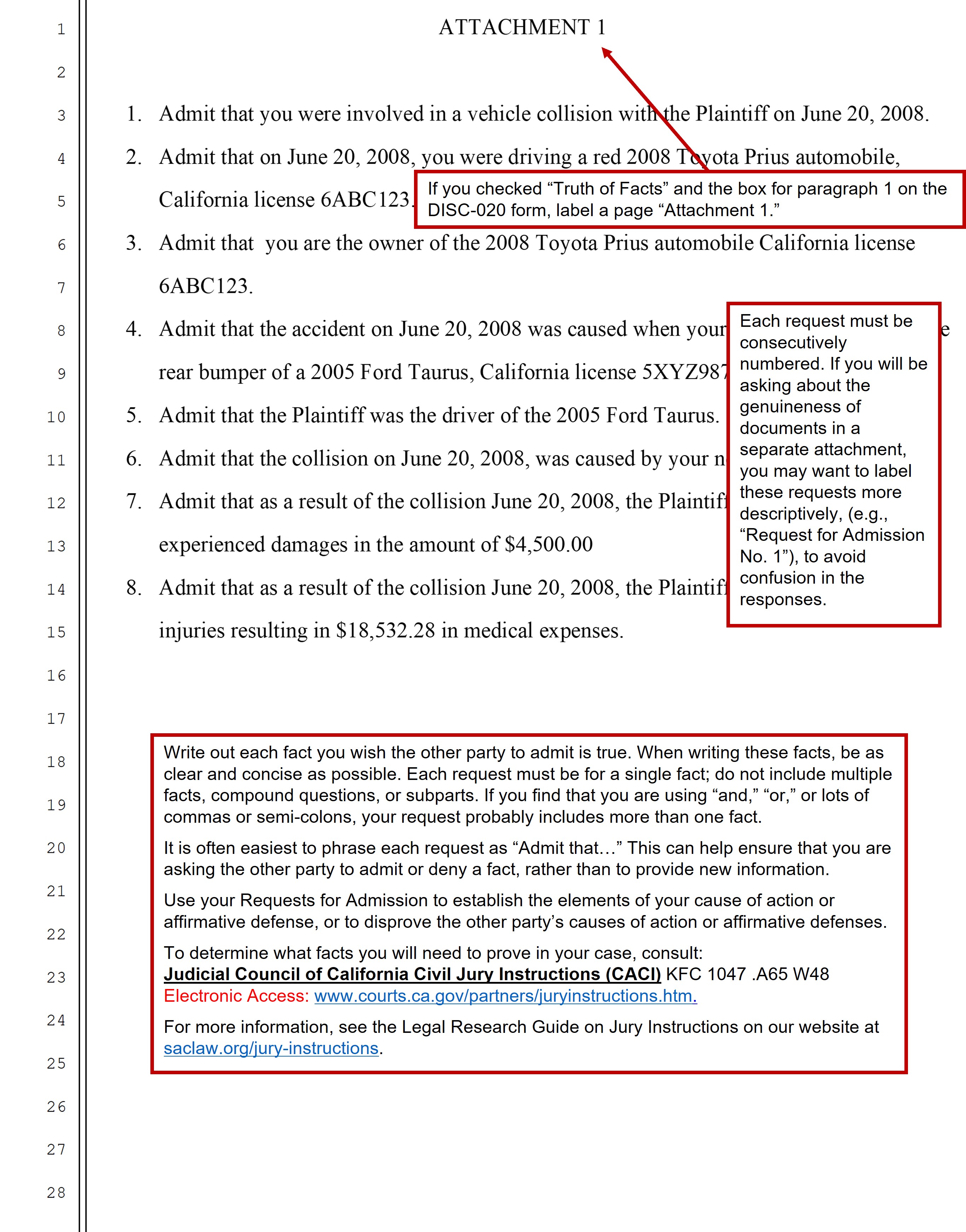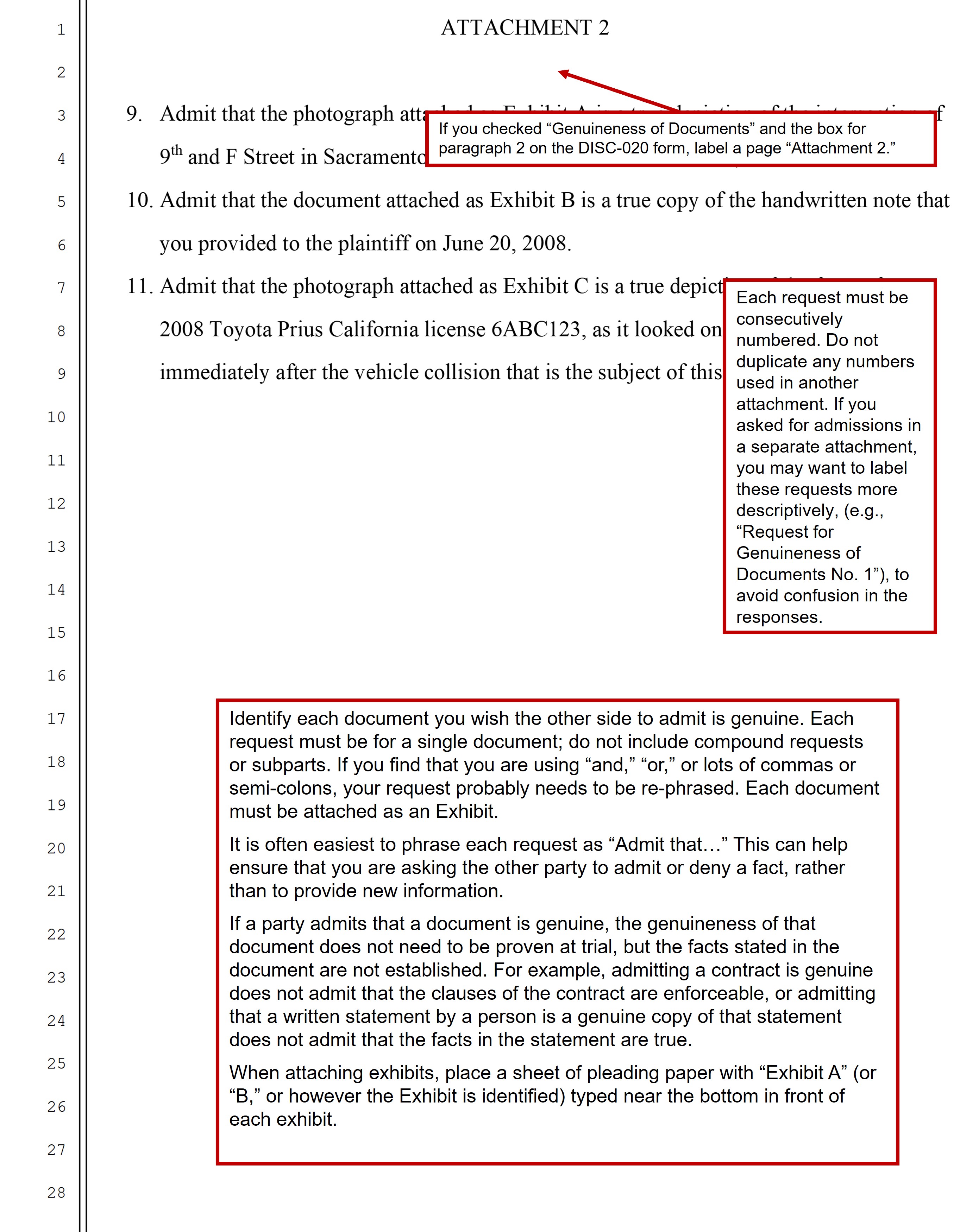Discovery: Requests for Admission
Templates and Forms
Requests for admission are used to ask another party to admit that certain facts are true, or that certain documents are authentic. If admitted as true or authentic, these facts and documents do not need to be proven or authenticated at trial. This helps narrow the scope of controversy in the case, making trials quicker and less expensive.
Ideally, the facts you need to win your case are undisputed, and the other side will admit that these facts are true. If all the key facts are admitted or deemed true, you may be able to file a motion asking the judge to issue a judgment in your favor, because there are no factual issues to be tried.
You may also need…
Step-by-Step Guides on Responding to Discovery
- Responding to Interrogatories
- Responding to Requests for Admission
- Responding to Requests for Production
Step-by-Step Guides on Making Discovery Requests
Other Guides on Discovery
Related Videos
Jury instructions are a good way to know what facts you will need to prove in order for you to win your case. The California Civil Jury Instructions (CACI) are available for free online. If you find the jury instructions appropriate to your case, you will have a list of the facts each side must establish to win the case. For more information, see our guide on Jury Instructions.
If the responding party fails to respond to your Request for Admission, your remedy is to ask the court to deem each of the facts true, so be sure to phrase your requests so that, if a fact is deemed true, it helps your case. You don’t want to ask the court to deem facts true that are detrimental to your case!
California law places strict limits on the number of discovery requests a party can make. In a limited civil case (cases less than $25,000, or $35,000 if filed after Jan. 1, 2024) you may ask each party only 35 questions total, whether they are form interrogatories, special interrogatories, requests for admission, or requests for production of documents. Keep this limit in mind when writing your requests, to ensure that you are able to obtain all the information you’ll need for your case. If you ask the other party to admit 35 facts, you will not be able to serve any interrogatories or request any documents.
If you determine that you cannot obtain all the necessary information in 35 requests, the parties must either agree to additional discovery, or the party requiring the additional discovery must file a motion with the court asking for permission to propound more discovery requests. See the sources listed at the end of this Guide for more information.
In an unlimited civil case (cases over $25,000, or $35,000 if filed after Jan. 1, 2024), each party may make 35 requests for admission. Any number over 35 may be asked if the request contains a declaration of necessity, a sworn statement in which the party or attorney declares under penalty of perjury that additional discovery is required. The form of this declaration can be found in California Code of Civil Procedure (CCP) § 2033.050.
To keep within these limits, you may be tempted to try to squeeze as much as you can into each fact you wish admitted. Be careful in doing this; CCP § 2033.060 prohibits parties from writing requests that include multiple facts, compound questions, or subparts.
Step-by-Step Instructions
1
Complete the Necessary Forms
The Judicial Council form commonly used in this procedure is:
The Requests for Admission (DISC-020) serves as a cover sheet, and includes legally required language and important instructions for the responding party. You must also attach your requests for admission, listing the facts you wish the responding party to admit are true. Your requests must be written on pleading paper; you may download blank pleading paper from this link:
Each request must be numbered sequentially. Requests must be clear and concise, and request that the party admit a single fact. Do not include multiple facts in a single request, and do not use compound questions or subparts. Instructions for completing the Requests for Admission (DISC-020) and a sample attached pleading are at the end of this Guide.
2
Make Copies
Make one photocopy for each party (other than you) in the case. Create a packet for each party, with Requests for Admission (DISC-020) and all attachments stapled together.
3
Have Your Requests Served
A photocopy of your request must be served on the attorney for the responding party or directly to the responding party if he or she is self-represented (in pro per). Courtesy copies should be served on all other attorneys or self-represented parties in the case. Service may be completed by mail, by a person over the age of 18 who is not a party to the case. The person serving your requests must complete a Proof of Service by First Class Mail (POS-030). For more information, see our guide on Proof of Service by Mail.
4
Retain Your Originals
The original Requests for Admission (DISC-020), attached pleading(s), and signed Proof of Service (POS-030) should be retained for your records. If the other party does not respond to your requests, you may use these documents to support a motion to have the court deem the facts true. For more information, see our guide on Motions to Deem Facts Admitted.
For More Information
On the Web:
Video: Introduction to Discovery – Part 2: Request for Admissions
Part 2 of this video series from SH@LL (Self Help At the Law Library) will help you understand what Requests for Admissions are, and how to propound these types of requests.
At the Law Library:
California Civil Discovery KFC 1020 .H64
Electronic Access: On the Law Library’s computers, using Lexis Advance.
California Civil Discovery Practice KFC 1020 .C35
Electronic Access: On the Law Library’s computers, using OnLaw.
California Civil Litigation and Discovery KFC 995 .G674
California Deposition and Discovery Practice KFC 1020 .D44
Electronic Access: On the Law Library’s computers, using Lexis Advance.
California Discovery Citations KFC 1020 .F56
California Forms of Pleading and Practice KFC 1010 .A65 C3 (Ready Reference)
Electronic Access: On the Law Library’s computers, using Lexis Advance.
California Practice Guide: Civil Procedure Before Trial KFC 995 .W45
Samples



This material is intended as general information only. Your case may have factors requiring different procedures or forms. The information and instructions are provided for use in the Sacramento County Superior Court. Please keep in mind that each court may have different requirements. If you need further assistance consult a lawyer.






